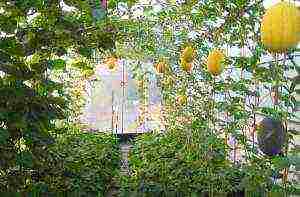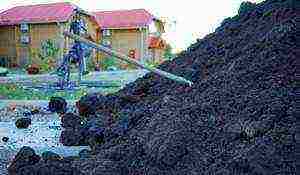Content [show]

Breeding cattle is a profitable business, so the question often arises of how to fatten a bull for meat in a short time. This can be done with the help of special preparations that are added to food and drink. They contribute to an increase in body weight, accelerate the growth of animals, but at the same time they are absolutely harmless to their body. You can use such additives on the farm and at home. The main thing is to correctly calculate the dosage.
Basic rules for feeding livestock
For a calf to gain weight faster, it needs to eat properly. It is recommended to have a special notebook and note in it how much the bull weighs and what feeding methods are used. Feed should be given three times a day at regular intervals. Each farmer decides for himself what to feed the bulls, but there are certain principles that must be adhered to.
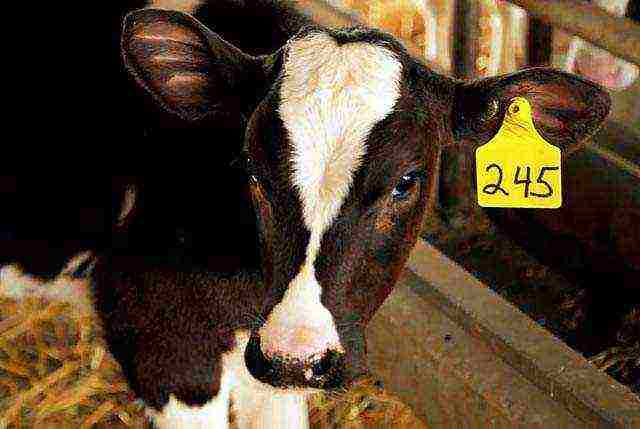
In the first two months, the animals need to be given only milk, and then gradually begin to introduce wheat grits and good hay. In this case, it will be possible to achieve rapid growth of bulls and eliminate stomach problems.
From 3 to 6 months, cattle require a large amount of protein to gain muscle mass. They can be obtained from vegetables, crushed grains. From 7 months, about 10-15 kg of dry or fresh grass is introduced into the animal's diet per day. Its quantity needs to be increased every day. If you use this method of fattening, the calf will begin to gain up to 600 g per day. The animal will not suffer from hunger, but also will not receive an excessive amount of food.
The best age for slaughtering calves is 1.5 years, but with more intensive fattening, the time is shortened.
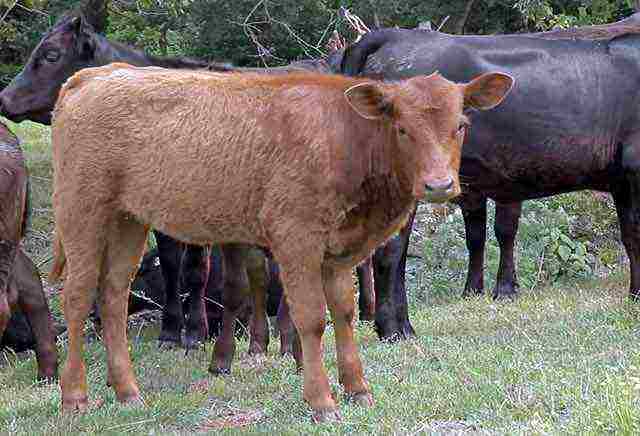
Fattening on grain forage
You can quickly fatten bulls at home with the help of special additives. The probiotic "Lactobifadol" works effectively. It should be added to food during each feed until slaughter. In this case, the animals need to be fed three times a day: at 6, 14 and 22 hours.
It is best to feed the bull with crushed forage. Its daily volume should be gradually increased:
- at 2-3 months - no more than 0.6 kg per day;
- at 6 months - maximum 3.5 kg daily;
- at 12 months - up to 9 kg per day.
When using this scheme, the weight of the bulls by the year will be about 500 kg. When livestock reaches 14 months of age, they should receive up to 10-14 kg of grain per day. This norm is observed up to 1.5 years, when the weight of the animal reaches 650 kg.
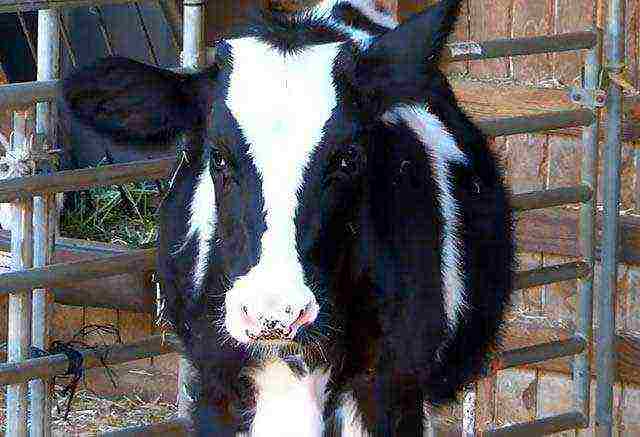
Such feeding allows you to gain weight up to 1.6 kg daily. It is best to select forage from equal proportions of barley and wheat.You can use only one type of grain, but in this case, the final weight of the bulls will be slightly lower. This method is very effective and cost effective. The amount of meat obtained can be increased to 60%, which will significantly affect the monetary profit.
Feed additive "Supermix"
The supplement "Supermix" has a positive effect on the fattening of bulls. About 150 g of this product is required per day per individual. The exact amount must be calculated according to the instructions, as it depends on the age and weight of the livestock.
Supermix can be used on the farm and at home. The supplement contains growth stimulants, minerals, vitamins and flavorings that increase feed intake.
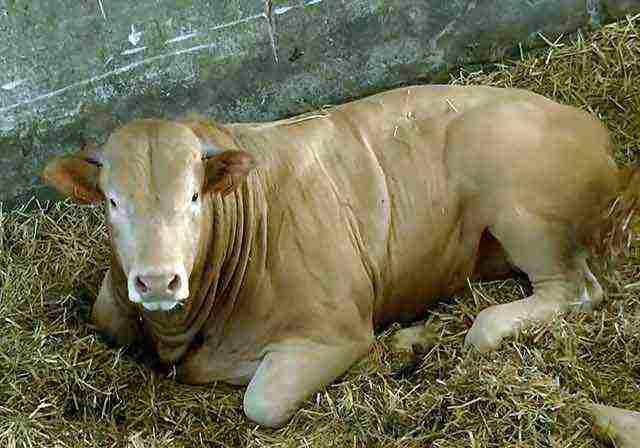
Regular use of "Supermix" allows you to get a large gain in the shortest possible time, reducing the feeding period by 1.5 months. In addition, it will be possible to reduce the total amount of feed required for raising a bull. He will not eat 1 ton of compound feed, but about 750-800 kg.
There are no harmful substances in this supplement that can negatively affect the health of the animal. But, in order for the meat to acquire a marbled appearance, "Supermix" must be added up to slaughter.
Are antibiotics effective?
Well-fed livestock will weigh more with antibiotics. When using them for a month, the weight will be 4-5% more. After 3 months, it will be possible to achieve an increase of up to 15%. This result will last up to six months, and then the body mass of the bull will begin to decrease. By the year it will weigh only 8% more than when fed without antibiotics.
Experts are still debating how best to administer antibiotics. In the course of the experiments, it was found that with intramuscular injections and infusion of the drug through the mouth, the bull gained less weight than when the agent was added to the feed.
If you decide to stop on injections, then you need to do them twice a day. Streptomycin and Penicillin are usually used to stimulate growth. In most cases, the calves will quickly grow in size. Their appetite will increase, and it will be possible to give hay from 5 months.
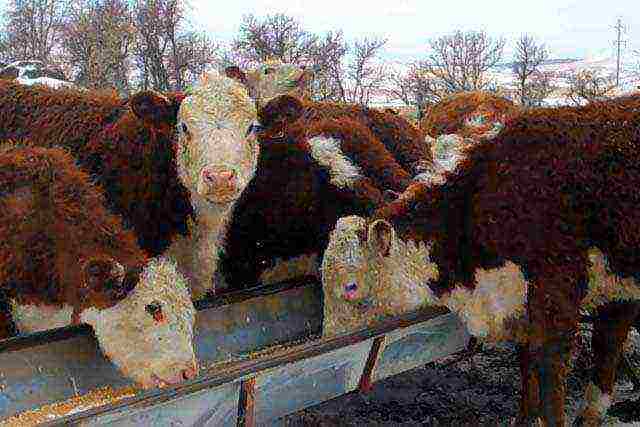
However, antibiotics do not work equally well on all animals. Sometimes drugs of the tetracycline series are not effective. The cattle grows slowly and has little weight gain. This happens when the dosage of the drug is chosen incorrectly, breaks are made in taking the medicine or the diet is unbalanced.
Prebiotic feed "Prestarter"
The prebiotic Prestarter has proven itself well. It contains all the necessary minerals and vitamins, cellulose prebiotics. The drug not only accelerates growth, but also has a positive effect on immunity, improves digestion and the development of the proventriculus.
Feeding with prebiotics should be started already on the 4th day after birth. Up to 7 weeks, the drug should be mixed with milk and given to calves in this form. If accelerated rearing of animals is practiced, "Prestarter" is used throughout the entire period. It is added to food according to a certain scheme, which is indicated in the instructions.

You need to read it carefully to understand how to feed livestock for rapid growth, otherwise there will be no result. Depending on the breed, calves gain up to 600 kg in weight. They need to be fed 4 times a day at regular intervals. When using Prestarter, animals should always have a sufficient amount of drinking water.
Application of the biostimulator "Kresacin"
Today, farmers often use the biostimulant "Kresacin", which reduces the feeding time of animals and increases their appetite. When using this tool, the average daily weight gain of livestock rises to 15%. "Krezacin" can be added to feed only after six months.
The drug is absolutely harmless and does not accumulate in the body. It is a synthetic product that is completely soluble in water. It is added to livestock feed or drink. For 1 kg of weight, no more than 0.010 g of "Crezacin" is required.
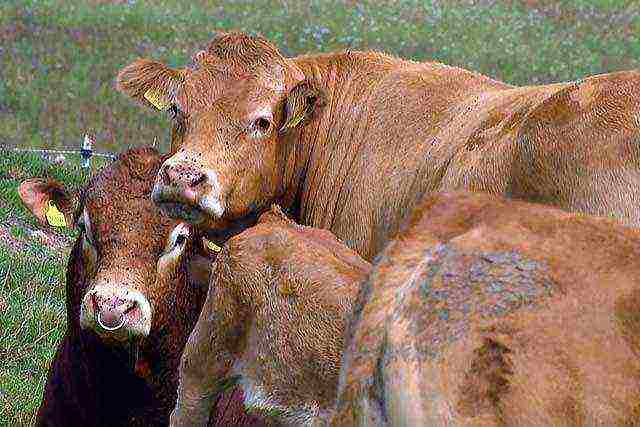
The tool has a good effect on the quality indicators of meat. The volume of the pulp increases by about 6%, the energy content by 5%, the protein content by 3%, and the dry matter content by 2%. The meat retains moisture well, so less is boiled during heat treatment. In addition, if you use "Krezacin" in the spring, then the goby, fed by it, is characterized by increased sexual activity.
Additive "Ivan Ovsinsky FEED"
"Ivan Ovsinsky FEED" is a growth stimulator for cattle. Calves gain weight faster, they have better appetite, better protein digestion and digestion works well. The use of the drug allows to reduce the cost of feed by up to 10%, but at the same time to significantly increase the weight of animals and their productivity.
The additive is used according to a specific scheme. It is used from the 20th day of life at the rate of 0.1 ml per 1 kg of animal weight. The drug is added to liquid feed or drinking water. A month after the start of admission, you need to take a break for 1.5 weeks. After that, the drug is used for another month, but already at 0.12 ml per 1 kg of weight, and again a break. Then - 0.14 ml per 1 kg during the entire growing period.
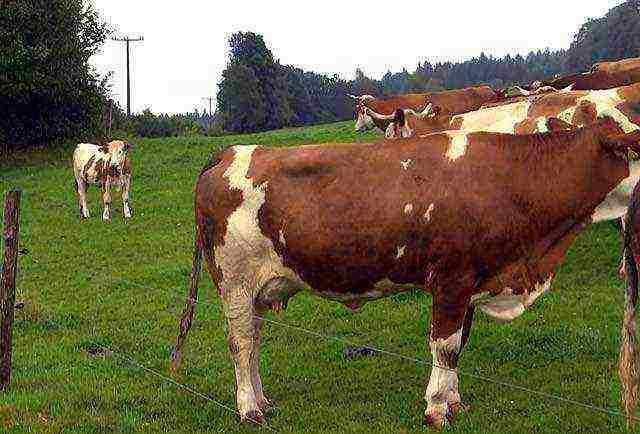
"Ivan Ovsinsky FEED" speeds up the rearing of animals and improves their productivity. When using the drug for 4 months, the weight of calves will be about 15% more than on normal feeding.
If you liked the article, please like it.
In the comments, share your ways to speed up the fattening of bulls.
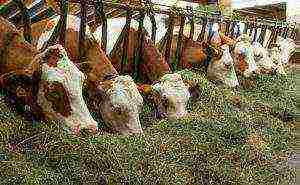 Breeding cattle is considered a profitable business, and therefore many novice livestock breeders ask themselves the question: what is the most effective fattening of gobies? One way to tackle the problem is to add supplements mixed with food and water, which will increase muscle mass. They promote rapid growth without harming the body of the animal itself. The additives are used both by owners of private farms and by owners of large complexes.
Breeding cattle is considered a profitable business, and therefore many novice livestock breeders ask themselves the question: what is the most effective fattening of gobies? One way to tackle the problem is to add supplements mixed with food and water, which will increase muscle mass. They promote rapid growth without harming the body of the animal itself. The additives are used both by owners of private farms and by owners of large complexes.
Basic rules for feeding
Calves need the right diet to gain weight quickly. It is best to get a special journal in which you can record the weight gain, as well as one or another feeding technique. Most farmers settle on a three-time food distribution schedule at the same time intervals. And if each owner makes an independent decision about the ingredients, then he adheres to certain rules described in zootechnics.
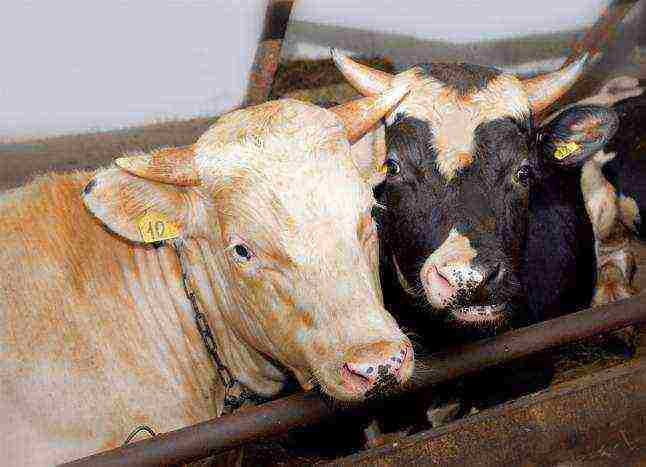
From the postpartum period until day 60, the calves are fed with milk, followed by a supplement of good quality wheat and hay. Such a diet promotes rapid growth and eliminates problems with the digestive system.
From 60 to 90 days, preference is given to foods with a high protein content, which help to gain muscle mass. This includes vegetables, crushed grain. From day 120, dried or fresh green mass in the amount of 10 - 15 kg is the next addition. This rate must be increased every day. This method of fattening gobies for meat at home leads to weight gain of up to 0.6 kg per day. At the same time, the young do not starve, but they also do not receive food in such an amount that will only be harmful.
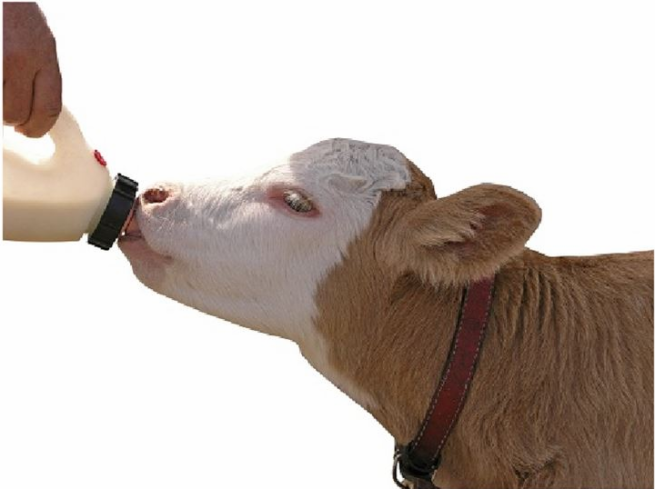
The most optimal time for the delivery of animals to the slaughterhouse is one and a half years of age, but if we take intensive feeding as a basis, then this period will be significantly reduced.
What should be the diet?
There are a large number of feeding schemes that start from the moment the bull is born. Such technologies allow you to get the desired result in a short time with the greatest effect of gaining muscle mass. It is especially important to adhere to certain norms when it comes to getting marbled beef. Based on the rations already compiled by specialists, each owner can make his own based on what is at hand.
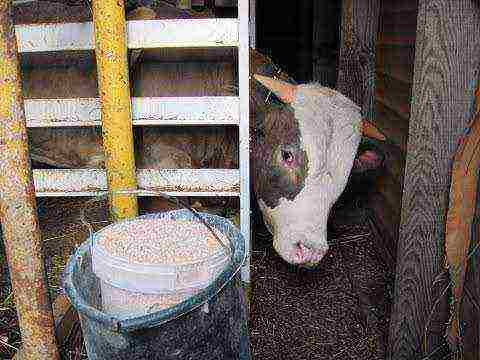
If we talk about the principles of feeding, then there is a summer and winter menu. In the warm season, the basis is green mass with additives of concentrates. In winter, there is no grass, but the animals need to eat something, and therefore its lack is compensated by other components. Further, you can familiarize yourself with an approximate diet for the cold season, which consists of the following ingredients:
- hay can be replaced with straw, but the first option is preferable;
- roots;
- supplements consisting of probiotics and vitamin complexes;
- fodder dry grass harvested in summer.
As for the feed itself, all products, without exception, must be of high quality. Spoiled products lead to indigestion and poisoning, as a result of which there is weakness and a predisposition to a number of other diseases.
How much food does an animal need per day?
During the day, the bull should consume:
- hay - 3-4 kg;
- root vegetables - 4 kg (large vegetables are recommended to be cut into several parts);
- concentrates - 2 kg, per head.
Every day, the animal will gain weight and grow, which means that adjustments will have to be made to the existing diet, taking into account the needs of the young.
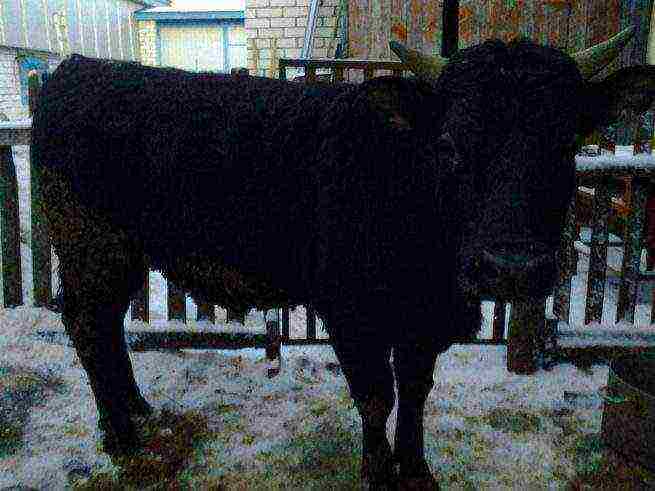
Note to the livestock breeder! In winter, compound feed is given instead of green mass. But with the onset of the grazing season, animals must be transferred to the grass, but this must be done gradually so that there are no problems with digestion. Otherwise, there will be no positive result, and the whole case may end with the death of the young.
Types of feeding
Use of grain forage... If you use special additives, then the fattening of gobies for meat at home is carried out several times faster. The most affordable means is "Lactobifadol", which is added to feed throughout the life of the animal until the moment of slaughter. As for the time of distribution of food, it is different in each household.
Good weight gain is obtained when using crushed grain forage, with a daily increase in its quantity.
| Age group | Amount of feed |
| 60 - 90 days | Not more than 0.6 kg per day |
| 180 days | 3.5 kg every day |
| 365 days | 9 kg daily |
| 425 days | 10-14 kg daily |
The proposed scheme makes it possible to obtain a weight gain of up to 500 kg by one year of age. Feed at the last rate is given before slaughter. Use either grain mixtures, for example wheat and barley in a 1: 1 ratio, or grain of the same type. In the latter case, the weight gain may be slightly less. The advantage of this type of feeding is efficiency and economic benefits.
Using the bagasse.This technology allows you to achieve daily weight gain from 800 to 1000 grams.
| Feed type | Feeding stages | ||
| Start | Middle | Completion | |
| Sour pulp | 45 | 40 | 40 |
| Cereal hay | Do not give | Do not give | 1 |
| Straw | 3 | 3 | 2 |
| Syrup | 0,5 | 0,5 | 1 |
| Rub the corn | Do not give | Do not give | 0,4 |
| Bran | 0,7 | 1 | 1,3 |
| Legumes | 0,2 | 0,3 | 0,2 |
| Salt | 30 | 40 | 50 |
| Feed phosphate | 60 | 60 | 60 |
The amount of feed is given in kilograms, excluding salt and phosphates, their amount is in grams.
Silo use.With this type of feeding, the average daily weight gain is 950 - 1000 grams.
| Name of feed | Feeding stages | ||
| Initial | Average | The final | |
| Corn silage | 30 | 25 | 20 |
| Wheat straw | 3 | 2 | 1 |
| Meadow hay | 1 | 1 | 2 |
| Grain concentrate | 1 | 1,3 | 1,6 |
| Bran | 0,3 | 0,3 | 0,3 |
| Salt | 20 | 30 | 35 |
| Feed phosphate | 50 | 60 | 70 |
The amount of feed is given in kilograms, excluding salt and phosphates, their amount is in grams.
If none of the listed options are suitable, and preference is given to exactly those products that are at hand, you can try the following technology. Here, an individual approach is carried out based on the conditions of detention and the food supply:
- distribution of special preparations to drinkers;
- fresh juicy feed;
- green mass with hay or straw during the transition period, transfer to grass.
From the age of six months, you can give food waste from a person's table, again initially in a small amount, gradually increasing it.This is the way most private farmers choose because of its benefits. For example, potatoes should be boiled and mashed. There is a gradual accustoming of young animals to the type of feed available on the farm, and if the event is successful, then there should be no problems with fattening calves to obtain meat products.

It only allows adjusting the rations, but not completely changing them, and therefore even a beginner will be able to raise calves on a home farm. The main thing here is setting the correct task and applying efforts to its implementation, and in this case, it will be possible to achieve the desired result without much effort. Animals are kept in an intensive way, in order to obtain products as soon as possible, but at the same time not to the detriment of livestock.
Feed additives
Premixes developed by specialists have a significant positive effect on animal feeding and muscle gain. It is to them that the Superpremix additive belongs. They give it at the rate of 150 grams per animal. As for the exact amount, here you need to know the weight, age group of calves and look at the detailed instructions offered to the drug.
The additive is suitable for both large livestock complexes and home farms. It contains mineral and vitamin supplements, a stimulant that affects growth, as well as a perfume that contributes to better feed consumption.
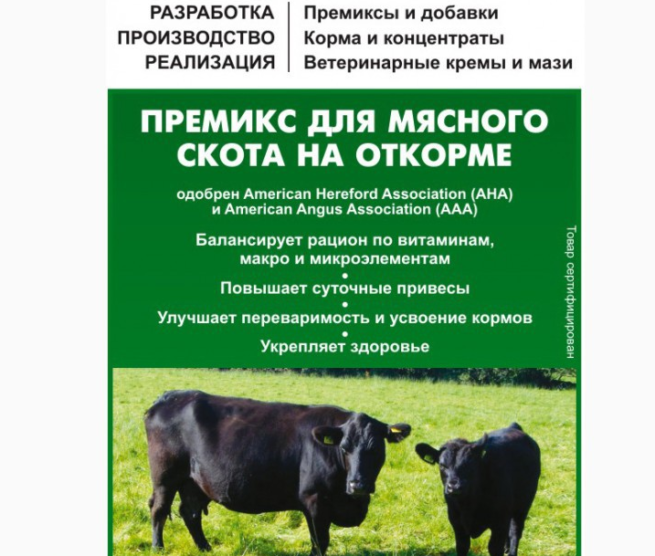
With regular use, animals have a good set of muscle mass, and at the same time the feeding period itself is reduced by 42 days. In addition, less feed is consumed, which is very beneficial for the owner of the farm. And if under normal conditions about a ton of compound feed is consumed per bull, then in this case they are reduced to 800 kg.
"Superpremix" does not contain harmful substances that have a negative impact on the health of young animals. To obtain marbled meat, the additive is fed to slaughter.
Antibiotics
You can get a lot of weight in animals during fattening with the use of antibiotics. If they are used for 30 days, then the mass increases to 5%. After 90 days, this percentage reaches 15 and the effectiveness remains for 6 months, then the indicator will decrease. By the age of one year, the difference will be only 8%.
There is no clear agreement among specialists on how to administer antibiotics. Experiments have shown that intramuscular injections and oral administration are less effective than mixing drugs with feed.
When using injections, you need to know that they are given twice a day. To influence the growth rate, you can use "streptomycin" or "penicillin". With the correct calculation, a rapid increase in young stock begins in size, their appetite increases, and hay can be started from the fifth month.
Prebiotics
“Restarter” has good recommendations, containing mineral and vitamin supplements, as well as a prebiotic of cellulose. Affects the growth rate, increases immunity, promotes the good functioning of the digestive system, develops the proventriculus.
The prebiotic is started at four days of age. At first, up to 21 days, the drug is mixed with milk and fed to young animals. With the accelerated version of cultivation, the use of "Restart" is recommended for the entire period according to the instructions, so you can get the desired result.
Affect feeding and breed characteristics, some gobies by the end of the period can weigh about 600 kg. Feed is distributed 4 times a day. The main rule is that when adding "Prestarter" animals must be provided with access to water.
How are biostimulants used?
Today, many livestock owners use "Krezacin", which has a significant impact on the timing of fattening, by increasing the appetite. If you use such a drug, you can achieve a daily weight gain of about 15%.
It's important to know! The use of "Krezacin" is allowed only from six months of age.
"Krezacin" refers to harmless drugs that do not accumulate in the body. It can be added to both feed and drinking water, where it will completely dissolve. Calculation of such dosage per 1 kg of mass is not more than 0.010 g of biostimulant.
Cereal additives
The use of cereals and legumes is the path to rapid weight gain in bulls. Animals raised on this feed give soft, tender meat products, eating green mass containing fiber and vitamins. The diet is intensively reared and young animals gain weight well.
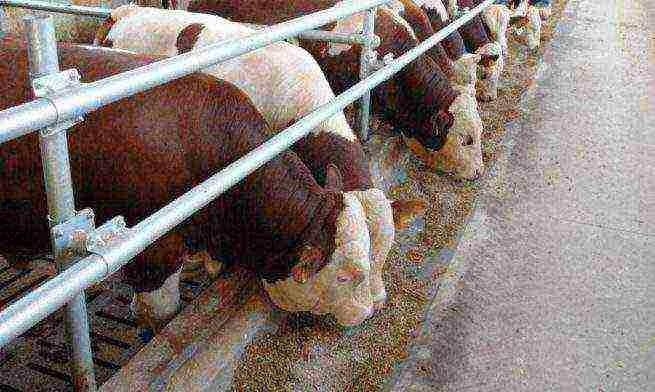
For a home farm, it is important to pay attention not only to the quality of the feed, but also to the place of distribution. The premises where animals are kept must be clean so that pathogenic microorganisms cannot cause this or that disease. Do not think that all the maintenance of cattle consists in the distribution of fodder and the pasture of livestock, here you need to put a lot of work to get good meat products. The above recommendations apply to all breeds of cows: Simmental, Holstein and others.
Some helpful tips
Raising young stock for fattening has its own nuances, and begins with sending animals to pasture lands in the spring months after the appearance of green mass. It is important not to forget about the distribution of dry food here.
A person who has no experience with livestock is advised to think carefully about everything: how to keep calves, how to feed them, how to protect them from diseases and death. There should be no problems with feeding, because all rations have been freely available for a long time. They need to be carefully read and based on the fodder supply available on the farm.
Note to the farmer! Bulls, when organizing the right conditions of detention, together with decent food, will give stable weight gain. It is much more difficult to achieve exactly the same result from cows. It is recommended to think over the entire feeding technology in advance, even before the livestock appears in the farmstead.
The way to get quick weight gain is chosen in such a way that the bulls gain weight without feeling hungry.
Hungry livestock can eat feed indiscriminately, and this is harmful not only to health, but also has a negative impact on the quality of meat products. Youngsters from one year of age should receive special additives in feed or drinking water to stimulate muscle gain. Also, the diet may contain cereal feed: a mixture of sprouted grain with barley, containing useful trace elements.
Having decided to start fattening gobies for meat at home for the subsequent sale of products, each person should remember that being a supplier is not as easy as it seems - it is associated with a huge responsibility.
Video. Fattening bulls: the most effective at home
»At home
Fattening bulls
The appearance in a household where there is at least one cow, a young bull, is not considered a rarity, but many owners, fearing difficulties with feeding and keeping it, prefer to immediately sell such an animal to breeders, or for meat, which from an economic point of view is not the right decision, since with proper fattening, a bull can reach over 400 kilograms of live weight, while its value will increase tenfold.
Diet for feeding gobies
Bulls They are able to gain live weight faster than cows, and already by the age of 12 months weigh up to 300 kilograms, therefore their maintenance and breeding is extremely beneficial for a farmer who plans not only to make money on the sale of meat, but also to leave himself considerable parts of the carcass for personal needs.
Bulls are not picky in their diet, they eat almost everything that they are given, and since no one is going to milk them, the taste and smell of feed does not play a role in fattening bulls.
The daily diet of young calves and bulls must necessarily include milk, both whole and skimmed, hay, roughage and dry feed, root crops, concentrates, various additives that can affect the growth rate of the animal and the absorption of feed by them.
Calves who have not reached six months of age must consume more than 200 liters of whole milk and skimmed milk. This rule applies to bulls of beef breeds, while dairy bulls by this time should consume a little less than 200 liters of whole milk and 600 skimmed milk. In the first week of life, the bull should be fed on milk alone; dry food in the form of hay can be introduced only in the second week of the calf's life. This amount of milk allows the bull to gain up to 800 grams of weight per day.
In addition to hay, juicy meadow and field grasses are introduced into the diet of spring calves, feeding with which is the best beginning of intensive feeding aimed at bringing the bull to the maximum possible body weight.
Experienced farmers are well aware that the longer the calf is fed milk, or at least whey, the faster it grows. If there are several cows on the farm and mass production of cheeses, it is strongly recommended to give the remaining whey after this process to bulls, diluting potato, carrot and other peelings with it.
An adult cow eats up to 70 kilograms of hay and other feed per day, but in the bull's diet the amount eaten should be increased to 100-120 kilograms, including green, dry, coarse and concentrated feed.
They feed the bulls 2-3 times a day, trying to replace half of the feed in the usual daily diet with silage, and in the absence of such other nutritious feeds - corn, leguminous hay and wheat. Of particular benefit to bulls is the introduction of corn leaves into the diet.
Fattening for meat at home
Bulls are left in households in two cases - for meat and for breeding. For breeding bulls for meat, they must be provided with a large amount of high-quality and nutritious feed that can have a positive effect on the animal's weight gain.
In animal husbandry, it is generally accepted to raise bulls up to 15-20 months maximum, after which they slaughter and further sale of meat. Enhanced feeding of bulls lasts throughout the entire period of rearing, but in the last three months before slaughter, animals are fed especially intensively, combining such feeding with restricting the movement of livestock. Most of the time, bulls intended for fattening spend in the barn, being tied to their stall with several chains or ropes, which is necessary due to their steep disposition, which can cause clashes with other animals and even humans. In addition, limiting movement allows you to gain weight faster than grazing bulls in a herd, as is the case with cows. In addition, in order to help build up their appetite, bulls are daily taken to fresh air and forced to wander around the pen for several hours in a row, after which they immediately give a large amount of swill and dry hay.
The raising of bulls for the purpose of obtaining meat on large livestock farms is carried out according to specially created feeding schemes, providing that the animal must gain at least 600 grams of weight per day. In the household, it is also advisable to use such schemes, since it allows you not to make mistakes when feeding the bull, not to overfeed or starve the animal, due to your own erroneous ideas about raising it.
In addition, such a scheme is easy to draw up on your own, guided by the following provisions:
- Gobies at the age of 1-2 months are fed exclusively with milk and skim milk, with the addition of a certain amount of hay, or well-dried green grass.Such feeds contribute to the rapid weight gain of the animal, but they are effective only at the initial stage of feeding, since they do not contribute to the development of the size of the stomach, which directly affects the amount eaten. Gobies are taught to coarse dry feed from the second week of life, feeding them a little hay and dry wheat groats
- It is quite difficult to fatten bulls at the age of 3-6 months, therefore farmers resort to various tricks, trying to feed animals a feed rich in protein, which has a beneficial effect on muscle growth and, accordingly, on the amount of meat. In the period from 6 to 9 months, the muscle mass of calves comes to an optimal balanced state, therefore, during this period, calf meat is considered the most delicious and nutritious.
- To build muscle mass in summer, calves are almost completely transferred to pasture, while in winter they are given large quantities of hay, silage and haylage.
If the farm has a large amount of potatoes, it is advisable to feed the bulls with this product. At the end of autumn, it is the potato that can become the product that can contribute to a significant increase in the weight of bulls. In addition to potatoes, bulls are also fed pumpkins, watermelons, fodder watermelons and zucchini. Before feeding vegetables and fruits, it is necessary to rinse several times with running water, and also inspect for the beginning of decay processes, mold and the like. Before distributing the root vegetables to the feeders, they should be cut and immediately given to the cows to avoid blackening. At the end of the harvesting of cereals, bulls should be given finely chopped spring straw, chopped fodder beets, corn silage, oats and other feed available on the farm.
An important component of feeding is the presence in the feed given to bulls of a large number of proteins, proteins, fats, carbohydrates, trace elements, minerals, vitamins that can increase the weight of the animal.
Calves, put on the right fattening, outwardly extremely well-fed, rarely get sick and eat well. A special place in fattening is occupied by the percentage of coarse, dry and succulent feed in the diet of both a young calf and an adult bull.
Keeping a bull in an ordinary home courtyard is not at all easy, but it is quite possible, because with proper feeding, just one bull can help out a lot of money and get a lot of high-quality meat.
To feed one bull a year, a few hundredweight of hay is enough, the same amount of compound feed, a large stock of straw, chaff, silage, haylage, dry corn and other feed available on the farm.
Before starting fattening, it is better for the farmer to obtain consultation check with your veterinarian and make sure there is enough feed available to keep the bull from malnutrition during the winter. Correct feeding implies an increase in the weight of a bull by the first year of his life, 7-8 times compared to what he had at birth.
The quality of feeding depends on when the bull is slaughtered. Farmers planning to slaughter bulls by autumn intensively feed the bulls throughout the spring and summer, while those who plan to leave the bull for the winter do not, trying to gradually transfer the animal to cheap feed.
The final stage of fattening is considered to be feeding, which begins 1-2 months before slaughter. For feeding, it is necessary to have at least one high-quality pasture of at least 3 hectares for one animal. The bull can be on the walk all daylight hours, always in a tied state, which does not allow him to move quickly and thereby lose the weight he just walked.
An important rule of feeding is the observance of clear charts feeding, as well as its gradual change. A sudden switch to green and succulent food in the spring can poison the animal and be fatal.
In addition to the main feed for fattening, bulls are also given a certain amount of table salt.The norm of salt per bull is from 50 to 100 grams per day, depending on the weight of the bull.
At the end of fattening, the bull should weigh over 300 kilograms, have rounded sides, a large thick neck, round head and correct posture. Thinness when the bull consumes a sufficient amount of nutritious food may indicate the presence of a latent disease in the animal. It makes sense to feed such a bull, even in a household, is not profitable until it is completely emaciated, it is best to pass it on for meat.
The effect of castration on the weight of a bull when fattening
Most farmers castrate bulls at an early age, which saves them from the need to fight the steep temper of the bull in the future, but negatively affects the feeding process itself. Bulls that have not undergone the castration procedure grow and gain muscle mass many times faster than castrated ones, reaching one year of age, such bulls weigh on average 20 kilograms more than castrated ones, in the future this difference will only increase.
Castrated bulls consume more feed, while their meat is more fatty, therefore it is not suitable for those who follow a diet. Castration is usually performed before the calf is 3 months old, which negatively affects muscle development and can lead to severe obesity. Experienced farmers try not to do this, castrating bulls when they reach the age of one year, which does not in any way affect their muscle mass gain.
Thus, it is quite profitable to fatten bulls for meat in a small-scale farming environment, if you have your own range and stocks of feed, you will practically not have to take care of the bull, the main thing is not to forget about feeding the animal three times a day, as well as having access to drinking water. It should be noted that water should be given no more than once a day, in quantities that can quench the animal's thirst, but not cause loss of appetite, which should not be allowed in any case.
How to raise calves at home
Raising calves at home requires a lot of effort, especially during the dairy season. But if properly cared for, raising calves on your own will prove to be a much more profitable process than purchasing an expensive adult calf.
Calving a cow and caring for a newborn
The cow carries the baby for 9 months. When calving begins, the cow is moved to a fenced-in area covered with clean straw. Childbirth is often natural and correct. The animal pushes during attempts and pushes a bluish-red bladder with amniotic fluid from the vagina, which soon bursts. The front legs of the calf appear first, then the head, then the rest of the body. You should not help and pull the calf if the birth is normal. In case of complications, you should ask for help from specialists or experienced neighbors.
The calf lies at first, resting and gaining strength. At this time, it is necessary to separate the umbilical cord: cut it off with clean scissors or tear it off by hand. In this case, it is necessary to firmly grip the part that remains with the newborn so that bleeding or injury does not occur near the abdomen. Rinse the umbilical cord with 7% lysol solution.
The baby comes out of the womb wet due to amniotic fluid. Usually the cow licks it herself and warms it. If she does not do this, it is necessary to wipe and dry him yourself so that he does not catch a cold. After this procedure, the calf should be placed in a dry and slightly cool place without drafts. Then there is a hardening of a small organism, a delay in the development of microbes and a decrease in the risk of morbidity, which will greatly facilitate keeping the calf at home.
How to set up feeding
With proper housekeeping, it is advised that when raising calves during the dairy period, do not allow babies to be fed with the uterus. The cow usually gives much more milk than the baby needs.He can drink an excessive amount and the young body will not be able to assimilate it, which will lead to disorder.
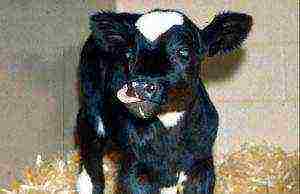 It may be the other way around. The calf will not have enough strength to suck the cow clean, which is why her milk yield will soon decrease.
It may be the other way around. The calf will not have enough strength to suck the cow clean, which is why her milk yield will soon decrease.
You can also try:
- do not let the baby suck out the milk to the end and give it with his hands, but in this case, the cow may begin to retain milk
- milk, then attach the calf, but then the owner will receive the most liquid part, and the fatty afterbirth will go to the young animal, which is also unprofitable.
Livestock breeders recommend training calves to feed from a bucket or gang.
Calf feeding
The feeding ration depends on the age of the young. Conventionally, the rearing of calves is usually divided into periods:
- Milk - from birth to 3-4 months.
- Post-milk - from 3-4 months to 6 months.
- Fast growing - from 6 to 12 months.
- Final - from one to one and a half years.
The first week of life, the newborn is fed with colostrum, which is secreted by a cow. It differs from milk in consistency and taste, because it includes more proteins and mineral salts, 4–5 times and 2 times, respectively. Colostrum is fed to the baby 3-4 feedings, 1.5 liters daily. This special nutrition is important for further stimulating growth and developing immunity to various diseases.
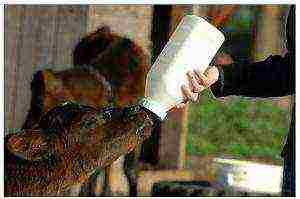 At the same time, they begin to give fresh skim milk (return), warmed up to 35–37%. At the same time, they gradually accustom themselves to hay. Better if it is a vitamin, mowed before flowering plants. From the age of 25 days, they begin to give hay infusion. To prepare it, you need to grind the hay and fill it with boiled water, heated to 70–80 degrees, at the rate of 6–7 liters per 1 kg of hay. The broth must be infused for 5–6 hours and drained. First, they give a dose of 0.25 liters, gradually this figure reaches 5 liters.
At the same time, they begin to give fresh skim milk (return), warmed up to 35–37%. At the same time, they gradually accustom themselves to hay. Better if it is a vitamin, mowed before flowering plants. From the age of 25 days, they begin to give hay infusion. To prepare it, you need to grind the hay and fill it with boiled water, heated to 70–80 degrees, at the rate of 6–7 liters per 1 kg of hay. The broth must be infused for 5–6 hours and drained. First, they give a dose of 0.25 liters, gradually this figure reaches 5 liters.
Calves aged from six months to 1 year are transferred to solid food. The daily portion consists of 6-7 kg of carrots and beets, 1 kg of straw, 3-4 kg of hay, 0.5 kg of concentrates, 4-5 kg of silage, 25 g of salt and feed phosphate-containing substances or chalk. The menu for a one-year-old calf consists of 7-8 kg of beets, carrots or potatoes, 5 kg of hay, 6-8 kg of silage, 2 kg of straw, 0.5-1 kg of concentrated feed, 40-45 g of salt and 30-35 g. feed phosphate-containing substances or chalk.
Daily routine and place of detention
Raising calves during the dairy period requires a correct and precise daily routine. Determine the timing of feeding, cleaning the room and hygiene of the baby himself. It should be adhered to to avoid morbidity in the calf.
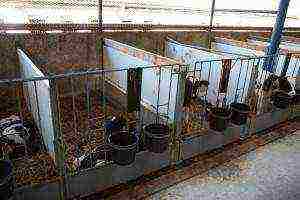 First, the newborn is placed in a cage standing on legs 30–40 centimeters high. The floor should be grated so that waste does not remain in the pen. To ensure comfort and warmth, cover the bottom with straw, preferably wheat or rye, with a layer of at least 30 centimeters. The top of the litter needs to be re-matted every day and can be completely replaced once a month. Never use wood shavings or wet straw, as this can make your baby sick.
First, the newborn is placed in a cage standing on legs 30–40 centimeters high. The floor should be grated so that waste does not remain in the pen. To ensure comfort and warmth, cover the bottom with straw, preferably wheat or rye, with a layer of at least 30 centimeters. The top of the litter needs to be re-matted every day and can be completely replaced once a month. Never use wood shavings or wet straw, as this can make your baby sick.
After 20 days, the calf is transferred to the calf shed, first in a separate cage, then in a general one, designed for a maximum of 6 animals. The calf rearing room must be dry. If this is difficult, then place a bowl of quicklime in the corner, which absorbs excess moisture. Also, wood ash should be poured on the floor so that it clears the air and absorbs the ammonia smell from urine.
Walking
 A calf of 3-4 days of life can be released from the cage, but for now it should only walk indoors. Starting from 10 days of age, the baby is released into the pen for 5-10 minutes in calm weather. Walking time is gradually increased to 1.5-2 hours.
A calf of 3-4 days of life can be released from the cage, but for now it should only walk indoors. Starting from 10 days of age, the baby is released into the pen for 5-10 minutes in calm weather. Walking time is gradually increased to 1.5-2 hours.
In the first months, it is necessary to train the calves to graze and feed on abundant young grass growing on solid ground. The first week grazing lasts 1-2 hours, the second - already 4-5, on the third - it's already 8-10.
Also, calves can and should be bathed in reservoirs with running water during the warm season.
Fattening gobies for meat
After the birth of newborn animals, the farmer thinks about whether they are suitable for further breeding of a dairy farm or for raising calves for meat. The diet and conditions of detention depend on this.
If there is a choice, calves from large dairy cows should be left for breeding from the third to the eighth calving. Firstborns are usually too weak, since the mother herself is not yet physiologically developed enough. Old-born animals are also unlikely to produce healthy offspring.
However, the mother's assessment should not be the determining factor, take a closer look at the newborn:
- a large calf with a wide head and shiny coat, stands firmly on its feet, gallops, hums loudly, has an excellent appetite - a good option for breeding development
- a small calf with dull hair, prefers to lie on a litter, reluctantly drinks milk - there will be no sense from it.
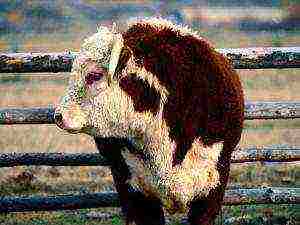 When raising calves for meat, it is better to feed them with one whole milk. The meat after such feeding is light, typical for good veal, it is most appreciated on the market. Skim milk, white bread, and raw chicken eggs can be added temporarily.
When raising calves for meat, it is better to feed them with one whole milk. The meat after such feeding is light, typical for good veal, it is most appreciated on the market. Skim milk, white bread, and raw chicken eggs can be added temporarily.
Care must be taken to ensure that the calf does not overeat, that the room is dry and draft-free, and that it receives chalk. A cage for such an animal is made small so that it cannot jump and spin in it, then the weight gain will go faster.
Feeding is carried out for 2-3 months. A well-fed calf produces a carcass weighing 55–60% of its live weight.
At home, raising calves will require small material investments, but huge labor costs. But no matter what you decide: to raise young animals for dairy farming or for slaughter, in any case, it will pay off.
Video How to raise a calf
Sources:
No comments yet!
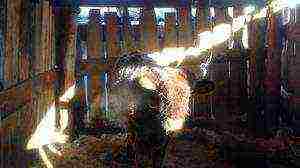 The business of raising calves for meat can generate significant profits, but this will require proper housing and the right diet for the calves. In order not to spend a lot of time caring for animals at home, it is recommended to purchase young animals already at the end of April so that they can be immediately put into herding. The absence of pasture near the farmyard will not be a serious hindrance either. You can make a special pen by choosing a place for it in the adjacent territory, remembering that one head should have 8-12 square meters. m.
The business of raising calves for meat can generate significant profits, but this will require proper housing and the right diet for the calves. In order not to spend a lot of time caring for animals at home, it is recommended to purchase young animals already at the end of April so that they can be immediately put into herding. The absence of pasture near the farmyard will not be a serious hindrance either. You can make a special pen by choosing a place for it in the adjacent territory, remembering that one head should have 8-12 square meters. m.
Characteristics of the diet of young animals
In winter, calves are fed as feed hay, root crops and compound feed... In summer, the diet is based on seasonal food - fresh grass. In order for the young animals not to experience a shortage of feed, they are harvested based on the average daily rate:
- hay - 3 kg;
- root vegetables - 2 - 4 kg;
- concentrates - 1.5 kg per head.
One-year-old calves need to be given a double rate of succulent feed, and the amount of compound feed is reduced to 1 kg. Livestock rations usually have the following composition:
- Concentrate booze.
- Juicy feed.
- Grass or hay.
When the calves are 6 months old, they food waste can be given... Potatoes are quite heavy food for calves, so they need to be prepared - boiled and crushed.
When raising livestock at home, green fodder begins to be given in small portions, since with a sharp change in diet, digestive problems may arise, and this will affect the weight gain. In the first weeks, it is allowed to add 10-15 kg of feed per head per day to the diet - it is given only after roughage. By the end of the week, its share should reach 70 kg. Concentrates with the addition of 50-100 grams of salt should be given twice a day.
The fastest way to achieve the desired weight gain is if the animals are fed with cereals, legumes and Compositae crops. It should be leaves that are a rich source of fiber, nutrients and vitamins.
When raising livestock at home, you need to regularly take care of the room itselfwhere the calves are kept - it must always be dry, for this it is necessary to remove the contaminated layer every day, change the litter once a month.
Where to start growing?
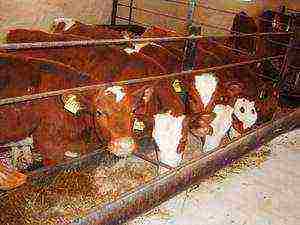 Most of all, this business is suitable for residents of rural areas: this business does not require much time during the year. It is enough to spend a little time and effort in the summer in order to get a good sum for the goby handed over for meat in the fall.
Most of all, this business is suitable for residents of rural areas: this business does not require much time during the year. It is enough to spend a little time and effort in the summer in order to get a good sum for the goby handed over for meat in the fall.
The most suitable place for purchasing young animals is dairy farms, where the required number of animals is kept in large quantities. In this case, you can be sure that the purchased breed is the one that was declared by the seller. When choosing a suitable breed, it is recommended to buy those that are grown in this region. Thanks to this, young animals will not experience difficulties with acclimatization during breeding.
Choice of livestock
When choosing young animals for growing for meat, it is necessary take into account the following characteristics:
- Must be 3-4 months old;
- Weight approx. 100 kg.
Taking care of young cattle is not so difficult, it is enough for them to simply find the right feed. Those who are going to raise only a few heads in order to have several bulls on their own farm, and donate some for meat, do not need to register. If you plan to breed a dozen heads, then you will have to draw up the documents of a private entrepreneur.
When raising a large number of bulls (from 10 heads), you service personnel will be required... The shepherd will be engaged in herding the calves, and the livestock keepers will provide the conditions for feeding and will maintain the premises where the livestock are kept in proper condition.
Also, you will have to repeatedly use the services of a veterinarian: to get preventive vaccinations and help in the treatment of cattle diseases.
Features of fattening heifer for meat
Raising bulls at home is not so easy for a novice entrepreneur. He must have a certain theoretical base that will help him choose the right feed for livestock, as well as create favorable conditions for housing and treatment. In the process of raising calves for meat it is customary to distinguish three main stages:
-
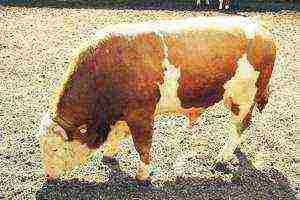 Preparatory. Its main goal is to provide young animals with a significant amount of food. Given their fussy eating habits, calves should have silage, hay and straw in their diets.
Preparatory. Its main goal is to provide young animals with a significant amount of food. Given their fussy eating habits, calves should have silage, hay and straw in their diets. - Main period. At this stage, you have to solve the same problems as at the first.
- The final stage. Calves already feel less need for food, so they have to adjust their diet by adding a lot of concentrates and juicy feed.
A significant weight gain can be achieved provided that a optimal meal schedule: They need to be fed three times a day at regular intervals. Before feeding the calves, it must be prepared in a certain way: grain crops must be chopped or steamed, potatoes must be boiled and kneaded, root crops must be peeled and washed. For better digestion, young grass must first be dried, it is added to the diet in small portions, gradually increasing the amount.
The presence in the diet of calves of feed that exceeds their physiological need has a positive effect on the development of muscles, weight gain, and meat quality.
Calves, which have been given insufficient feed for a short time, begin to grow actively already in the first weeks after switching to a normal diet. If, during the whole season, the young animals receive less food, then this leads to a lag in development.
A great help for the farmer is the presence of nearby processing plants - sugar, brewery or distillery... From them you can get food waste from production, which can be given to gobies already at the age of six months.
When raising calves for meat, special attention should be paid to the quality and quantity of feed. Considering these and other rearing recommendations, one-year-old calves can gain 7 times more in weight than at birth, and upon reaching the age of 1.5 years, they may have at least a tenfold weight gain.
How can you achieve good results?
 Any farmer who has been raising cattle for meat can confirm that this is a very profitable activity: in the absence of large labor costs, favorable conditions for the growth of calves and weight gain can be created in a short time.
Any farmer who has been raising cattle for meat can confirm that this is a very profitable activity: in the absence of large labor costs, favorable conditions for the growth of calves and weight gain can be created in a short time.
One of the key factors in obtaining high quality meat quickly is providing calves with quality feed in large quantities. They are especially needed by calves between the ages of 6 and 12 months. If the animals are poorly fed, then their bones and ligaments begin to actively grow, and the meat becomes tough.
Feeding methods
When raising calves for meat, you can choose one of the following feeding methods:
- Short. It takes a short period of time for a period of up to 1.5 years, upon its completion, the weight of bulls can be 400 kg or more.
- Long lasting. Assumes active feeding of young stock for 7-8 months. During this period, weight growth can be very rapid, and the indicator can reach 500 kg. The meat is of the highest quality - it becomes fatty and juicy.
- Average. Intermediate. This feeding option involves providing animals with an increased amount of feed compared to the previous method. Takes 5-6 months of time. As a result of rearing, animals gain 400-450 kg in weight.
Monthly calves are allowed to be grazed on pasture. Here they can be up to 16 hours a day... However, given their fragile body, care must be taken that water and shaded areas are present in the place of grazing.
In the absence of a meadow near the farmyard, bulls can be kept in a specially equipped corral with a canopy. One-year-old bulls need special attention - they must be tied in the pen, which will help form their calmer disposition and help them eat better.
Conclusion
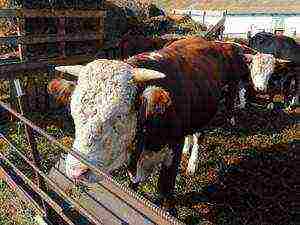 Raising bulls for fattening is a profitable business that even people who are far from this activity can do. However, without knowledge, it will be very difficult to succeed in this matter. The weight of animals and the quality of their meat depends on many factors. The decisive factor is nutrition, which must be balanced and fed to the calves in sufficient quantity.
Raising bulls for fattening is a profitable business that even people who are far from this activity can do. However, without knowledge, it will be very difficult to succeed in this matter. The weight of animals and the quality of their meat depends on many factors. The decisive factor is nutrition, which must be balanced and fed to the calves in sufficient quantity.
It is also necessary to choose the right breed of bulls, since when raising non-native livestock, it can be difficult to acclimatize. Do not forget that gobies, like all pets, are susceptible to disease, so you will have to be vaccinated and monitor your health throughout the entire time.
Rate the article:
(8 votes, average: 2.9 out of 5)
